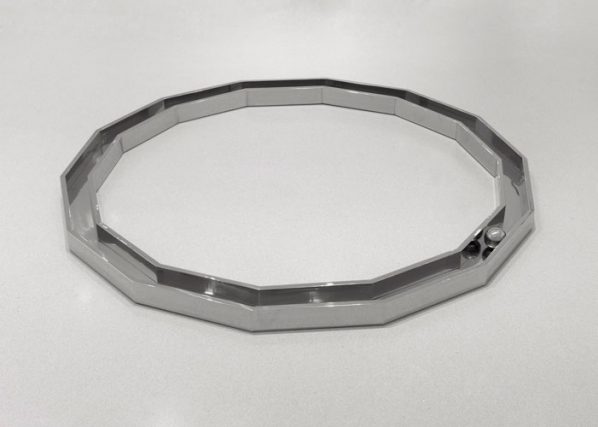
Walter De Maria, 14 Sided Open Polygon, 1984; Stainless steell with solid stainless steel ball, Polygon 4 (h) × 89 (diameter) inches (9.5 (h) × 226.1 (diameter) cm)
Gagosian Hong Kong is pleased to present “間 (jiān),” a group exhibition of Minimalist works selected in response to Dan Flavin’s the nominal three (to William of Ockham) (1963).
間 is a composite of the Chinese characters for sun and door, evoking a sliver of light between two pillars. It can be translated as interval, gap, space, or pause. This image-moment taps into the phenomenological aims of Minimalism, which used simplified forms to communicate the primacy of intellect and bodily awareness over artistic content.
Emerging from De Stijl, Constructivism, and Suprematism, as well as American mass production, Minimalism locates the content of an artwork in the viewer, rather than in the object. Artists such as Dan Flavin, Donald Judd, and Walter De Maria, all included in this exhibition, pursued a pure objecthood informed by existentialist philosophy and theories of being and nonbeing.
In the early 1960s, Flavin’s interest in elementary forms and industrial materials led him to develop site-specific arrangements of commercial fluorescent lights. Circumventing the limits of the gallery, he used the standard lengths of the tube lights to set up nonhierarchical interrelationships, blurring distinctions between the aesthetics of art and industry. the nominal three (to William of Ockham) (1963) is made up of six identical lights, three subsets positioned in a numeric sequence across a single wall. Displayed as parallel vertical beacons, the lights can be read from left to right: one light, then two, then three, exemplifying Flavin’s calculated awareness of the empirical realities of rooms.
De Maria took his calculations to the floor (as well as the land, in his earth works). His sculptures use mathematic permutations to produce sublime repetitions of basic geometric components. 14-Sided Open Polygon (1984) is a stainless steel channel containing a steel ball. Looking down upon this shiny tetradecagon, one imagines the ball rolling infinitely along the interior angles.
Often, Minimalism examines the realm between painting and sculpture. Judd, for example, became dissatisfied with painting in the late 1950s because he wished to present objects as themselves, rather than as representations on a surface. He sought to get rid of everything except for order, to reveal a self-defining structural logic in all forms. Untitled (88–28 A/B) (1984) is comprised of two rectangular units, aluminum boxes with blue Plexiglas panels, protruding from the wall. Instead of drawing attention to the qualitative realities of the space, as Flavin does, Judd brings awareness to the physical relation between object and viewer.
Minimalism requests that the viewer stand before steel, Plexiglas, and light and confront his or her own awareness. To hear the buzz of Flavin’s lights, see one’s distorted reflection in De Maria’s steel, and experience the surface tension of Judd’s boxes is to address one of life’s most elusive questions: our very existence.
About the artists
Dan Flavin was born in Jamaica, NY in 1933 and died in Riverhead, NY in 1996. Major retrospectives of his work have been organized by the National Gallery of Canada in Ottawa (1969), St. Louis Art Museum (1973), Kunsthalle Basel (1975), Museum of Contemporary Art in Los Angeles (1989), Deutsche Guggenheim, Berlin (1999), and Dia Foundation for the Arts (traveled, 2004–07). The Dan Flavin Art Institute was established in 1983 in Bridgehampton, New York.
Donald Judd was born in Excelsior Springs, Missouri in 1928 and died in New York City in 1994. He founded the Chinati Foundation in Marfa, Texas in 1986. Major exhibitions of Judd’s work include the Whitney Museum of American Art, New York (1968, 1988); National Gallery of Canada, Ottawa (1975); Stedelijk Van Abbemuseum, Eindhoven, The Netherlands (1987); and Tate Modern, London (2004). A major retrospective of Judd”s work is forthcoming at The Museum of Modern Art, New York.
Walter De Maria was born in Albany, CA in 1935 and died in Los Angeles, CA in 2013. Major exhibitions of his work include Fondazione Prada, Milan (1999); De Pont Foundation for Contemporary Art, The Netherlands (2005); Dia Art Foundation, New York (2010); Museum Brandhorst, Munich (2010); The Menil Collection, Houston (2011); and Los Angeles County Museum of Art, California (2012–13). Permanent or long-term installations include “The Lightening Field,” New Mexico (1977); “The New York Earth Room,” New York (1977); “The Vertical Earth Kilometer,” Kassel, Germany (1977); “The Broken Kilometer,” New York (1979); “Seen/Unseen, Known/Unknown,” Naoshima Contemporary Art Museum, Japan (2000); “Time/Timeless/No Time,” Chichu Art Museum, Japan (2004); and “Large Red Sphere,” Türkentor, Kunstareal Munich, Germany (2010).




























